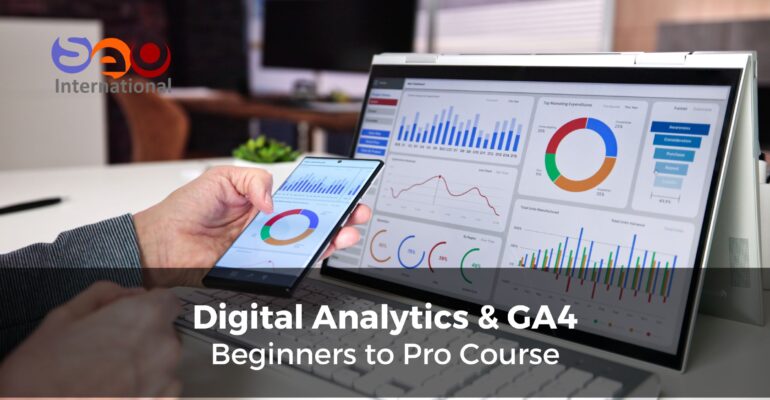Digital Analytics with GA4 – Beginners to Pro Course
July 17, 2024 2024-07-17 21:37Digital Analytics with GA4 – Beginners to Pro Course
Welcome to our free course (video tutorials) on “Digital Analytics with GA4 – Beginners to Pro”!
Digital analytics is the process of collecting, analyzing, and interpreting data from digital channels to understand and optimize user interactions. Google Analytics 4 (GA4) is the latest version of Google’s powerful analytics platform, offering advanced features and insights to help businesses improve their online performance. In this blog post, we’ll take you through a detailed journey of mastering GA4, from understanding the foundational concepts to advanced strategies that will elevate your analytics skills to a professional level. Our free course includes a series of video tutorials and official Google Analytics videos designed to guide beginners and seasoned users alike. Dive in and start your journey towards becoming a pro in digital analytics! Here are the first set of videos to get you started:
This video explains the different stages of a customer journey, from acquisition to engagement, highlighting their importance for optimizing marketing campaigns and improving user experience. Monetization and retention at the bottom of the funnel are emphasized for measuring customer conversion and loyalty. The video also shows how digital analytics provide valuable insights into customer behavior on e-commerce websites, helping businesses optimize performance and make informed decisions. Key insights on user behavior, such as how customers find and interact with a website or app and their purchasing patterns, are explored. This video is essential for enhancing your digital analytics capabilities with GA4.
How Google Analytics collects and processes data
In this video, the importance of adding a tag to your website for measuring user behavior and ad functionality in Google Analytics is explained. It covers how Google Analytics collects information about users’ devices, locations, and interactions. Events are processed into insights, such as tracking purchases on a confirmation page. The video also explains how the Firebase SDK gathers similar data for apps, providing insights into user behavior and interactions.
How to structure your Google Analytics account, property, and data streams
In this video, data streams in Google Analytics are explained, showing how they control data collection from websites and apps. Combining web data streams with cross-domain measurement ensures accurate reporting. Mapping accounts to your business structure is crucial. Examples include a gaming company and a food delivery service with separate properties for Android and iOS. The video also highlights Analytics 360’s flexibility for complex data needs with sub-properties and roll-up properties.
Create a new Google Analytics account and property
Set up website data collection for Google Analytics
In this video, creating a web data stream in Google Analytics involves generating a measurement ID and tagging your website. Google Tag Manager is recommended for easy code management and updates, centralizing all tags. Additionally, enhancing data collection with recommended and custom events provides detailed user behavior insights.
Here’s one more detailed tutorial for setting up a GA4 account and property by Analytics Mania:
Set up your app’s data collection with Google Analytics
This video explains that Google Analytics can create projects for apps that do not use Firebase, simplifying data collection setup. Setting up an app data stream in Google Analytics is a seamless process for developers. You can define and collect up to 500 different event names using the log event method in your app’s code, with no limit on total volume.
Confirm data collection is working in Google Analytics
The Realtime report in Google Analytics helps confirm successful data collection from your website. The event count by event name card is essential for this verification. If data isn’t appearing, it might be due to a website tag issue, and the help center offers guidance on resolving common problems.
For those seeking a more detailed tutorial on Google Analytics 4, we recommend checking out our comprehensive guide, “Google Analytics 4: A Complete Guide to Marketers,” available on our website. This blog post features longer videos with in-depth explanations and advanced strategies, perfect for those who want to delve deeper into the intricacies of GA4. Whether you’re a beginner or looking to enhance your existing knowledge, our complete guide offers valuable insights and detailed walkthroughs to help you master Google Analytics 4. You can find the guide here.
Manage user roles, data settings, and more
How dimensions and metrics power your reports
The user data, such as geographic location and device information, is sent to Analytics, offering a comprehensive view of user behavior. Dimensions like event names and metrics, such as the number of times an event is triggered, are crucial for understanding user engagement on websites and applications. A metric is a quantitative measurement, such as an average, ratio, or percentage. Additionally, custom dimensions and metrics can make your data even more useful and tailored to your business needs in Google Analytics.
Tour the Google Analytics 4 user interface – learn where to find reports, settings, and more
Create and manage events in Google Analytics 4
It explains that tracking e-commerce events like purchases and adding items to the cart is crucial for understanding user behavior and conversions. Google Analytics offers recommended e-commerce events for valuable insights. Custom events and parameters allow for tailored data collection. Creating custom dimensions and metrics in GA4 is easy, enabling users to customize reports. User scope dimensions, like geographic location, and item scope dimensions provide detailed information about user actions and product interactions.
Filter data and hide unwanted referrals
In this video, the setup of cross-domain measurement is explained, including the need for a shared measurement ID and editor permissions. Testing involves navigating between websites and checking for the linker parameter. Google Analytics identifies referral traffic sources and shows domain names as referral sources. Filtering out unwanted referrals is crucial for accurate data. Data filters prevent certain data from appearing in reports, and excluding internal and developer traffic helps maintain accuracy. Setting up internal traffic filters follows similar steps to regular filters, with an extra step. Note that filters only affect data from the point of creation onwards, not historical data.
Understanding and creating key events
Navigate Overview and Detail reports in Google Analytics
It explains how reports in Google Analytics monitor traffic, investigate data, and understand user activity. The acquisition overview and user acquisition reports offer insights into how users find your site. Understanding medium and source differences helps analyze traffic origins. Adding a secondary dimension like Country provides detailed user data. Sessions group user interactions, and the traffic acquisition report shows where new sessions originate.
Pre-defined reports in Google Analytics
This video explains the pre-defined reports in Google Analytics 4:
- Realtime Report: Monitors user activity, location, and device usage.
- Events Report: Analyzes event triggers and user interactions.
- Monetization Report: Tracks purchases and ad revenue.
- Publisher Ads Report: Provides ad engagement and revenue insights.
- Lifetime Value Card: Assesses user value based on revenue over time.
- Google Signals: Offers demographic data for cross-device reporting.
- Tech Reports: Identifies user technology for optimization.
- Tech Details Report: Analyzes device and screen resolution data.
Filter and compare data in reports
Use Explore for advanced analysis in GA4
Here are the key points of this video:
- Explore in Google Analytics: Uncovers more insights with ad hoc queries and in-depth data exploration.
- Freeform Exploration: Allows data visualization with tables, bar charts, pie charts, line charts, scatter plots, and geo maps.
- Cohort Exploration: Analyzes behavior and performance of user groups with common attributes.
- Blank Template: Provides a blank canvas for advanced analysis.
- Building Reports: Involves dragging dimensions and metrics to create tables on the canvas.
- Dimension Breakdown: Adds dimensions to rows for detailed analysis.
- Filter Functionality: Enables targeted data analysis.
- Segment Builder: Offers suggested and predictive segments for flexible data analysis.
Mastering Google Analytics 4 (GA4) is essential for anyone aiming to excel in digital analytics. Our course provides a comprehensive guide from foundational concepts to advanced strategies, ensuring you can fully leverage GA4’s potential. By following our video tutorials and official Google Analytics videos, you’ll gain valuable insights into user behavior, optimize digital channels, and make data-driven decisions. Start your journey today and elevate your analytics skills from beginner to pro with our free course.
Ready to dive deeper? Enroll in our Google Ads, AI, and GA4 Course (in Dubai, UAE) with a practical understanding. For more resources, explore Google GA4 on Skillshop to further enhance your GA4 expertise.



